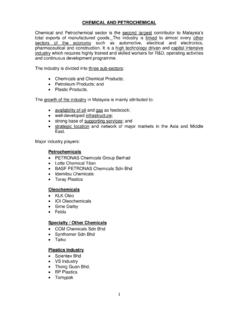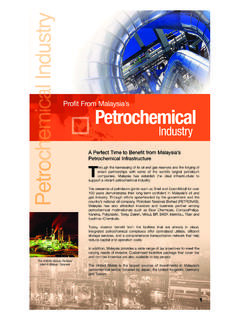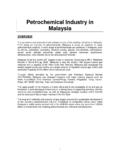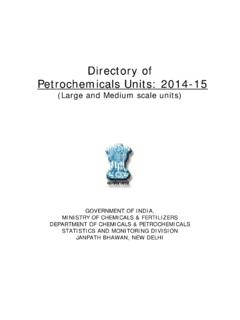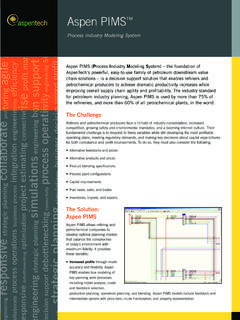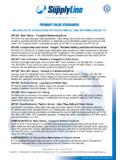Transcription of Petroleum Refinery and Petrochemical Plant Data …
1 Reproduced with permission, World Refining, July, 1999. (Fuller version than published one) Petroleum Refinery and Petrochemical Plant data IntegrationW. H. BOSLER, Texas Consultants, Inc., Houston, TX andDr. P. J. LAWRENCE, Resolution integration Solutions, Inc., Solon, OHThe success of Enterprise Resource Planning, ERP, systems and the structuralchanges in the business climate are dictating a change in the view and role of refiningand Petrochemical plants . When one looks at the dramatic changes in the electricalpower industry, one can make an inference as to the changes in store for refining andpetrochemical plants . While these changes are facilitated by the capabilities ofinformation technology and the intranet/internet, but the IT technologies are only assuccessful as the people who are using, assimilating, and applying those article presents a different way to view refineries and Petrochemical plants as partof the supply chain and a way to design for data integration of any application to anyother application via COTS software products---configurable/adaptable/integr atable-off-the-shelf software products.
2 The resulting nimble refiner or Petrochemical Plant is likelyto be the lowest-cost and highest-quality leader in the market. Being nimble is a result ofusers adapting the system to their current needs upon demand. Toyota implements 19suggestions per employee per year---they believe that this yields significant competitiveadvantage. COTS systems will do the same for refiners and Petrochemical with ERP SystemsISA s SP95 Control to Enterprise integration Standards Committee is developing datamodels and terminology for the data that needs to be interchanged between the ERPsystems and the Control Domain1. The high-level view of this integration is shown inFigure 12. Since SP95 addresses all industries, (discrete manufacturing, batch,continuous batch, and continuous Plant operations), the single data model requiressome interpretation for refineries and Petrochemical plants . Since these data modelsare meant to be object data models, the unique features of each facility can be Definition Information contains key elements of the production rules andsequencing with the bill of resources and bill of materials that both the enterprise andthe control domain need to effectively schedule.
3 (Please note this means the controldomain will know more details than the ERP environment, but those details are notcritical to ERP level scheduling.) For refineries and Petrochemical plants , this includes 1 ISA s SP 95 Enterprise-Control System integration Part 1: Models and Terminology Draft 12 has been releasedfor Committee Vote. For information, please contact Mr. Charley Robinson, SP95 Coordinator, The Int'l Societyfor Measurement and Control, 67 Alexander Drive, Box 12277, Research Triangle Park, NC 27709-2277;Phone: 919-990-9213; Fax: 919-549-8288; E-Mail: ibid., Figure 7 Petroleum Refinery andApril 17, 2000 Petrochemical Plant data IntegrationPage 2 Reproduced with permission, World Refining, July, 1999. (Fuller version than published one)all operating, regulatory and safety procedures, as well as, materials and skilledpersonnel required to produce a given product or series of CapabilityInformation contains all theinformation about the currentand planned status ofequipment, materials, andpeople.
4 Planned equipmentstatus includes all knownmaintenance schedulinginformation. For refineriesand Petrochemical plants ,this includes all equipmentand operating options for thatequipment, as well as theplanned maintenance andengineering changes to thatequipment over time. Theavailability (or not) ofcombinations of theequipment and units toperform specific tasks wouldalso be Informationcontains all the history andproduction schedule ofproducts, raw materials andintermediates. For refineries and Petrochemical plants , this information includes thegenealogy of the products, and unit operations, as well as all future is becoming a much more important element of Refinery andpetrochemical Plant product reporting. One refiner is reported to be settingup with the capability to specify the wells from which to draw his crude andthen monitor the unique segregation of that crude to (and through) therefinery to produce a specific product for a specific petrochemicalcompany.
5 Of course, the entire genealogy of operations and records areto be retrievable by product batch to the Petrochemical Plant . Coupled withthe genealogy through the Petrochemical Plant reactors, silos and mixers,one will be able to know the total genealogy of each lot of key part of this information is the production capability, as shown in Figure 23. 3ibid., Figure 15 Figure 1 SP95 Control to Enterprise IntegrationEnterprise InformationPlant Production Scheduling,Operational Management, etcManufacturingControl InformationArea Supervision, Production, Scheduling, Reliability, Assurance, etcProductDefinitionInformation(How tomake aproduct)ProductionCapabilityInformation (What isavailable)ProductionInformation(What tomake andresults) Petroleum Refinery andApril 17, 2000 Petrochemical Plant data IntegrationPage 3 Reproduced with permission, World Refining, July, 1999. (Fuller version than published one)This figure shows the committed, available and unattainable capability over current andfuture time.
6 As such, this considers all maintenance and new construction activities. Theconcept is to constantly publish all the information for any product schedulingapplication to be able to determine the available to promise, ATP, data for specificproducts to specific customers and to be able to commit the facility to so doing---withoutany other communication to the Refinery or Petrochemical is this ATP requirementthat will require dramaticchanges in the speed withwhich information ishandled within refineriesand Petrochemical is done today by e-mail, faxes, etc., betweenindividuals. In this model,the person using thescheduling program makesthe commitment. Thoseresponsible for performingthe activities will have thechallenge of making surethat they can deliver without retaining too much reserve in their published Functional ViewThis rapid informational need makes the implementation of the traditional level model of Refinery information needs obsolete.
7 That model treated information as beingaggregated at each level before being passed up to the higher level. The implicationwas that data at higher levels did not need to be refreshed very often. So while thelevel concept is still valid, the method of implementation is not. The levels are shown inFigure are several key concepts presented in Figure 34 that are even more valid todaythen when they were first developed. The Plant network is split into two logical pieces with a high-fidelity security device inbetween. Since every process instrument will soon have its own IP address, theneed for ensuring control of access to those IP addresses becomes even moreimportant. Also, a global two-phase commit management of change business 4 Figure 1, page 2, American Institute Recommended Practice 554, Process Instrumentation and Control, FirstEdition, September 2 SP95 Production CapabilityCapabilityProduction CapabilityUnattainable CapabilityAvailable CapabilityCommitted CapabilityTimeCurrent CapabilitiesCurrent Production CapabilityPetroleum Refinery andApril 17, 2000 Petrochemical Plant data IntegrationPage 4 Reproduced with permission, World Refining, July, 1999.
8 (Fuller version than published one)process will be required to keep all instrument, DCS, APC, MVC and applicationconfigurations synchronized. Since this drawing was completedwell before the breadth of the Internetintegration was known, it does notexplicitly represent the , access today across theIntranet and the Internet would connectto the Level 3B portion of the plantnetwork. While process operators will---by definition---be simultaneouslyconnected to both Level 3A and 3 Bportions of the Plant network (probablywithin the same Windows/NT PC), thefunctional capability of each connectionwill need to be properly controlled toguard against unauthorized access toLevel that OPC has the potential toevolve into a very powerful portal to thereal-time world5, the same security andcontrol issues need to be properlyhandled. Additional figures and text in RP554 clearly state that if one wants towrite an application to interact with theDCS either mono- or bi-directionally,then they should not talk directly to the DCS or other real-time devices.
9 Instead, theyshould talk to the real-time data historian. This was because oil companies foundthat the very expensive advanced process control person was spending over half ofhis/her time on issues related to the DCS, but not their current project; the resultantcode was dedicated to that DCS, so it was not reusable; and it was difficult tochange the DCS, since all the applications would have to be rewritten. During thistime frame, the DCS vendors have either developed or partnered with a company toprovide a real-time data historian (Figure 4). To satisfy the new requirements, that information will need to move up theinformation chain on demand, schedule or exception, an embedded business ruleagent will need to be continuously executing in the background. Since thisinformation moves directly into the ERP systems, the fidelity of the data will need to 5 Bosler s Guest Editorial in the March, 1999 issue of Hydrocarbon 3 API RP554 FunctionalInformation NetworkCONTROLLERSTRANSMITTERSCONTROLVAL VESCONTROLRP INTERFACECOMMUN-ICATIONDEVICEPROCESSCONT ROLCOMPUTERCONTROL SYSTEMPROCESS CONTROLCOMPUTERLEVEL 4 CORPORATENETWORKLEVEL 3 ALEVEL 3 BPLANTPLANTCONTROLNETWORKINFORMATIONNETW ORKLEVEL 2 UNIT CONTROLNETWORKLEVEL 1 CONTROLLERNETWORKLEVEL 0 SENSORNETWORKBUSINESS AND SUPPORTCOMPUTERSBUSINESS AND SUPPORTCOMPUTERSCOMMUN-COMMUN-ICATIONICA TIONDEVICEDEVICEFIGURE 1 -- FUNCTIONAL PROCESS INSTRUMENTATION, CONTROL,AND INFORMATION NETWORK ARCHITECTURERP INTERFACECOMMUN-ICATIONDEVICECOMMUN-ICAT IONDEVICECONTROL SYSTEMPROCESS CONTROLCOMPUTER 2 Petroleum Refinery andApril 17, 2000 Petrochemical Plant data IntegrationPage 5 Reproduced with permission, World Refining, July, 1999.
10 (Fuller version than published one)be improved. One way to improve the fidelity of the data would be to apply theknowledge learned from offline daily data reconciliation to online calculations toestimate the reconciled values. Hedging and other delivery requirements will dictatea business process to reliably predict these values and then to precisely deliver thepredicted values. Ideally, the combined efforts of the OPC foundation and thefieldbus foundation (FF) will lead to 1) OPC servers totally exposing theirconfigurations and accepting a download of a new configuration through a two-phase commit process; and 2) FF configurators to being able to manage those OPCconfigurations through a PSM hazop-style graphic to ensure full PSM and Functional ViewGiven this environment, the level or pyramid representation of information within eachfacility needs to change to an integrated view focused upon delivery against the missionstatement.
